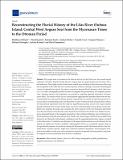Files in this item
Reconstructing the fluvial history of the Lilas River (Eu-boea Island, Central West Aegean Sea) from the Mycenaean times to the Ottoman period
Item metadata
| dc.contributor.author | Ghilardi, Matthieu | |
| dc.contributor.author | Kinnaird, Tim | |
| dc.contributor.author | Kouli, Katerina | |
| dc.contributor.author | Bicket, Andrew | |
| dc.contributor.author | Crest, Yannick | |
| dc.contributor.author | Demory, François | |
| dc.contributor.author | Delanghe, Doriane | |
| dc.contributor.author | Fachard, Sylvian | |
| dc.contributor.author | Sanderson, David | |
| dc.date.accessioned | 2022-05-12T06:30:11Z | |
| dc.date.available | 2022-05-12T06:30:11Z | |
| dc.date.issued | 2022-05-11 | |
| dc.identifier | 279545666 | |
| dc.identifier | 499e3298-a8be-485b-a432-69b21681f153 | |
| dc.identifier | 85130509680 | |
| dc.identifier | 000801654100001 | |
| dc.identifier.citation | Ghilardi , M , Kinnaird , T , Kouli , K , Bicket , A , Crest , Y , Demory , F , Delanghe , D , Fachard , S & Sanderson , D 2022 , ' Reconstructing the fluvial history of the Lilas River (Eu-boea Island, Central West Aegean Sea) from the Mycenaean times to the Ottoman period ' , Geosciences , vol. 12 , no. 5 , 204 . https://doi.org/10.3390/geosciences12050204 | en |
| dc.identifier.issn | 2076-3263 | |
| dc.identifier.uri | https://hdl.handle.net/10023/25348 | |
| dc.description | Funding: Aix-Marseille University. | en |
| dc.description.abstract | This paper aims to reconstruct the alluvial activity for the Lilas river, the second-largest catchment of Euboea Island (Central Western Aegean Sea), for approximately the last three and a half millennia. The middle reaches (Gides basin) exhibit several historical alluvial terraces that were first recognised in the 1980s but have remained poorly studied, resulting in uncertain chronological control of palaeofluvial activity. In order to reconstruct the past fluvial dynamics of the Lilas river, a ca. 2.5 m thick stratigraphic profile has been investigated for granulometry and magnetic parameters. Absolute dating of the sediments was possible by applying Optically Stimulated Luminescence (OSL). The results reveal: (i) two coarse-grained aggradational episodes dated from the Mycenaean/Early Iron Age and the Roman periods, respectively, (ii) a phase of rapid fine-grained vertical accretion corresponding to the Late Byzantine to early Venetian periods, (iii) potential evidence for final alluvial deposition from the Little Ice Age/Ottoman period, and (iv) two major incision episodes inferred from Ancient Greek times and most of the Byzantine period. Based on the published core material, the paper also evaluates the direct impacts of the Late Holocene alluviation recorded mid-stream on the fluvial system situated downstream in the deltaic area. Sediment sourcing is attempted based on the magnetic properties of the catchment lithology and of alluvium collected upstream along the main stream bed. Finally, the present paper discusses the possible links between Late Holocene hydroclimatic oscillations and the aggradational/incision phases revealed in the Gides basin. Correlations are attempted with regional palaeoclimate records obtained for the Aegean. In addition to climatic variability, anthropogenic factors are considered: specific land use for agricultural purposes, in particular during the Mycenaean period, the Roman and the Late Byzantine/Early Venetian periods, might have enhanced sediment deposition. Archaeological information and pollen records were also evaluated to reconstruct regional land-use patterns and possible impacts on soil accumulation over the last 3.5 millennia. | |
| dc.format.extent | 2164147 | |
| dc.language.iso | eng | |
| dc.relation.ispartof | Geosciences | en |
| dc.subject | Euboea Island | en |
| dc.subject | Greece | en |
| dc.subject | Lilas river | en |
| dc.subject | OSL dating | en |
| dc.subject | Stratigraphic profile | en |
| dc.subject | Granulometry | en |
| dc.subject | Magnetic parameters | en |
| dc.subject | Late Holocene | en |
| dc.subject | GE Environmental Sciences | en |
| dc.subject | CC Archaeology | en |
| dc.subject | 3rd-DAS | en |
| dc.subject | SDG 15 - Life on Land | en |
| dc.subject.lcc | GE | en |
| dc.subject.lcc | CC | en |
| dc.title | Reconstructing the fluvial history of the Lilas River (Eu-boea Island, Central West Aegean Sea) from the Mycenaean times to the Ottoman period | en |
| dc.type | Journal article | en |
| dc.contributor.institution | University of St Andrews. School of Earth & Environmental Sciences | en |
| dc.identifier.doi | https://doi.org/10.3390/geosciences12050204 | |
| dc.description.status | Peer reviewed | en |
This item appears in the following Collection(s)
Items in the St Andrews Research Repository are protected by copyright, with all rights reserved, unless otherwise indicated.

